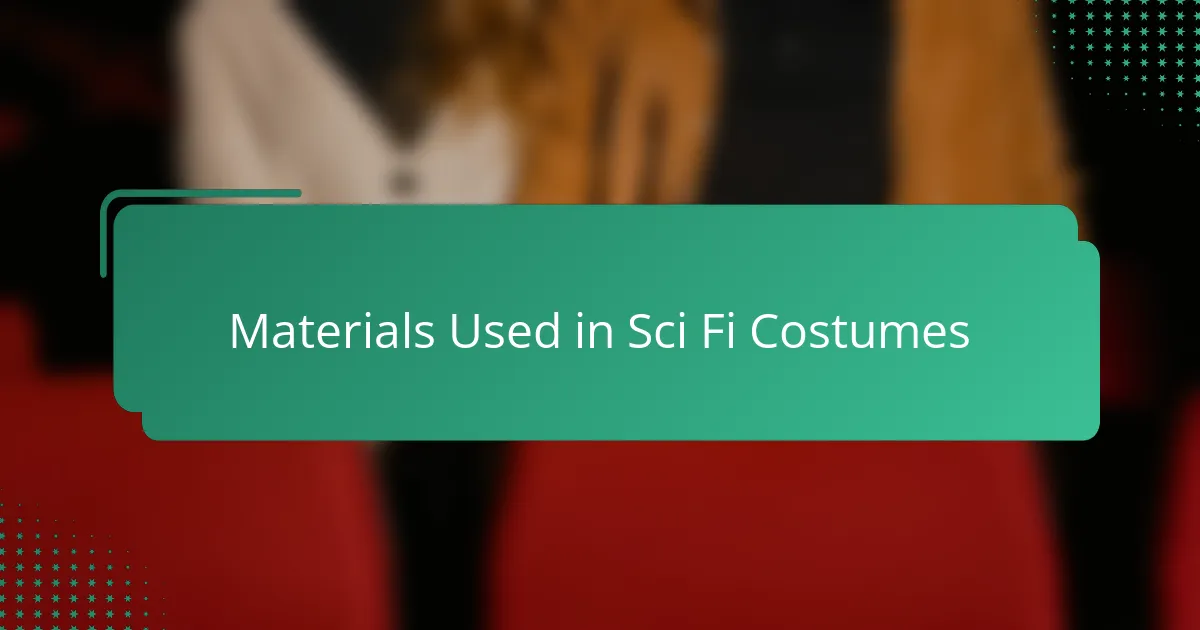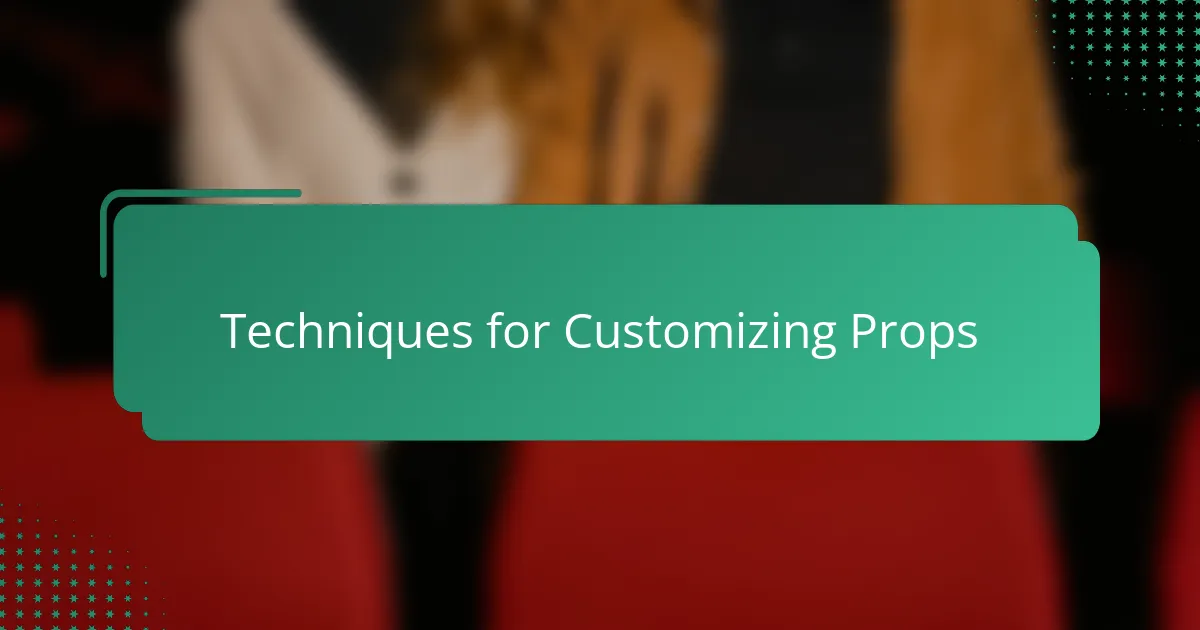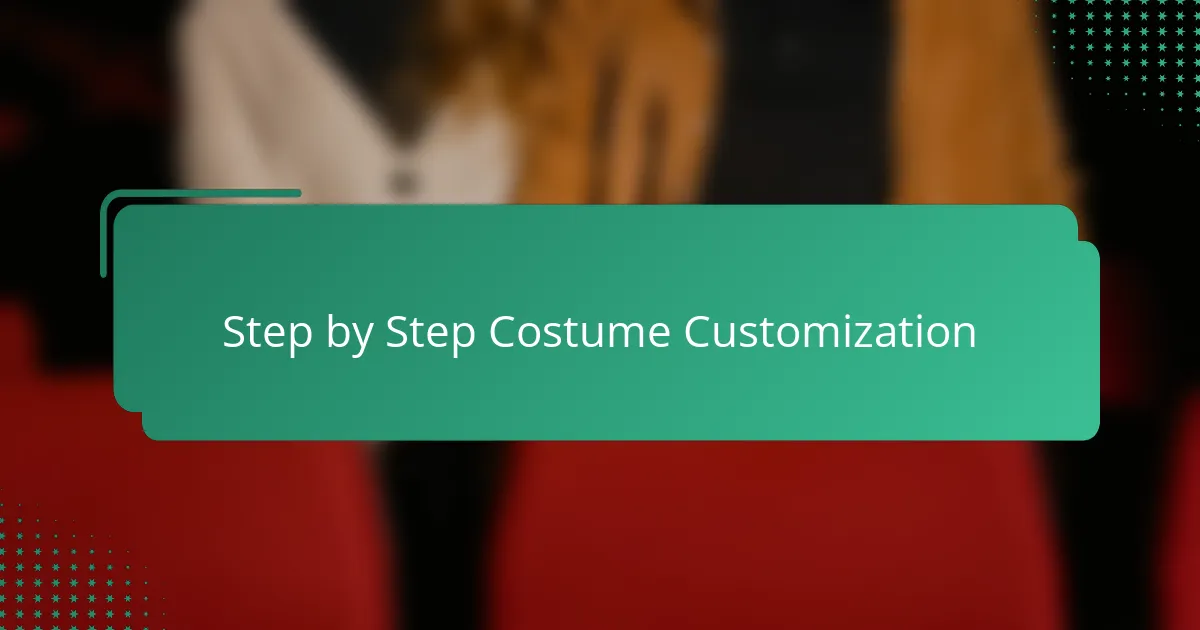Key takeaways
- Science fiction props serve as storytelling elements that enhance authenticity and emotional impact in costumes, like those in the Mad Max universe.
- Durable materials, such as leather and metal, combined with lightweight synthetic options, allow for comfort and creativity in costume design.
- Customizing props involves techniques like layering, weathering, and experimenting with materials to create a realistic and rugged look.
- Personalization, through unique details and functional elements, adds depth to costumes, making them feel distinctive and part of a story.

Understanding Science Fiction Props
Science fiction props are more than just objects; they’re tangible pieces of imagination brought to life. When I first started customizing my Mad Max costume, I realized how each prop tells a story about the world it comes from. Have you ever noticed how a simple gadget or weapon can instantly transport you into an entirely different universe?
Creating these props requires understanding their function and aesthetic within the story’s context. For instance, the weathered metal and worn leather in my Mad Max gear weren’t random choices—they reflected a gritty, post-apocalyptic reality. It made me appreciate how details in props contribute so much to the authenticity and emotional impact of a character.
What fascinates me most is the balance between creativity and practicality in science fiction props. How can something look futuristic yet believable? This question guided my design decisions, pushing me to innovate while staying true to the Mad Max universe. It’s this challenge that makes working with science fiction props so rewarding.

Materials Used in Sci Fi Costumes
When I gathered materials for my Mad Max costume, durability was top of mind. Using rugged leather and rusted metal scraps wasn’t just for the look—it made the costume feel lived-in and tough, much like the world Mad Max inhabits. Have you ever noticed how these textures instantly add a layer of grit and realism to sci-fi attire?
Working with materials like foam and plastic also opened up creative doors. They’re lightweight and easy to shape, allowing me to craft detailed armor pieces without feeling weighed down during wear. I’ve found that combining these synthetic materials with natural ones strikes the perfect balance between comfort and authenticity.
Sometimes, I’d stumble upon unexpected materials—like repurposed bike parts or old fabric belts—that sparked fresh design ideas. It’s amazing how everyday objects can transform into futuristic props when viewed through a sci-fi lens. Don’t you think that’s part of the magic behind customizing costumes?

Techniques for Customizing Props
Customizing props often starts with layering techniques that build texture and depth. For my Mad Max costume, I used a mix of dry brushing and weathering to mimic rust and wear—simple paint tricks that made plastic look like battered metal. Have you ever tried adding grime with diluted paint? It instantly gives props that authentic, battle-worn vibe.
Another technique I swear by is combining different materials for contrast. Mixing hard edges of metal scraps with flexible leather straps added both visual interest and functionality. It’s amazing how attaching one small gear or bolt can completely change a prop’s personality, don’t you think?
I also learned that improvisation plays a huge role in customization. Sometimes, I’d experiment by carving foam with a craft knife to create dents and scratches, then sealing it with a clear coat. It felt like giving my props scars—each mark telling a story from the harsh world Mad Max lives in. What’s your go-to method for making props look lived-in and real?

Tools for Creating Mad Max Costume
When I started building my Mad Max costume, the right tools quickly became my best friends. Simple things like a Dremel rotary tool helped me carve and shape foam with surprising precision, turning basic pieces into rugged armor. Have you ever tried cutting dense foam by hand? Trust me, the Dremel made all the difference between frustration and fun.
Besides rotary tools, I found that a sturdy hot glue gun was essential for fastening materials quickly and securely. Nothing beats that satisfying click as the glue cools and holds tough against the stress of wear and tear. I often kept a set of clamps nearby too—they let me keep pieces in place while the glue dried, preventing any frustrating slips or breaks.
For painting and weathering effects, I leaned heavily on smaller detail brushes and sanding blocks. These tools helped me replicate the scratches and rust that give Mad Max gear its authentic post-apocalyptic grit. I loved how using simple sandpaper to roughen edges could instantly transform smooth plastic into something that looked battle-worn and real. Have you ever thought about how much texture tells a story? These tools made that storytelling possible for me.

Step by Step Costume Customization
The first thing I did was sketching out every detail I wanted to include, breaking down the costume into manageable parts. It might sound tedious, but having a clear plan made each step feel purposeful rather than overwhelming. Have you ever tried building something complex without a roadmap? Trust me, it’s a game changer when you do.
Next came assembling the base elements, like stitching leather panels and shaping foam armor. I enjoyed the satisfaction of seeing rough pieces start to come together—each stitch and cut adding character to the costume. Sometimes, I’d pause just to admire how a simple adjustment brought the whole look closer to that gritty, worn-in Mad Max aesthetic I was aiming for.
The final stages involved layering weathering effects and attaching small props to amp up authenticity. I remember spending hours dry brushing rust and grime, feeling like I was coating the costume with its own history. Isn’t it amazing how these tiny details can turn a good outfit into a storytelling masterpiece? That’s where the magic truly happens.

Personalizing Your Mad Max Look
Getting personal with my Mad Max look meant diving into the little details that make a character truly mine. I experimented by adding unique patches and worn insignias that reflected the story I wanted to tell—like scars on armor, each marking marking a memory or a battle. Have you ever thought about how those small, personalized touches make a costume feel less like a replica and more like a second skin?
I also played with layering accessories, mixing found objects like chains and scraps that added depth and grit beyond the usual gear. It was thrilling to see how these additions turned a basic ensemble into something with its own rugged personality. Don’t you love when a simple prop suddenly feels like it has a story of its own?
Sometimes, stepping outside the typical Mad Max palette helped me find an edge—subtle shifts in color or texture can make a big difference. Adding hints of tarnish or distress in unexpected places kept my look fresh yet grounded in that harsh, unrelenting world. What’s your take on blending originality with the classic Mad Max vibe? For me, it’s a balancing act that keeps the costume alive and uniquely mine.

Tips for Enhancing Costume Authenticity
One tip I’ve found crucial for boosting authenticity is paying close attention to weathering. When I added layers of chipped paint and rust effects, it felt like my costume had lived through the harsh wasteland. Have you ever noticed how even subtle scratches or dirt can speak volumes about a character’s journey?
Another thing I learned is to focus on functional details—like buckles, straps, and fastenings—that not only look rugged but actually hold pieces together. It’s amazing how something as simple as a working clasp can elevate the realism and prevent the costume from feeling like just a static outfit.
Lastly, don’t overlook the power of layering textures. Combining rough leather with corroded metal and worn fabric created a tactile depth I hadn’t expected. Those contrasts invite closer looks and really immerse you in the Mad Max world. Have you tried mixing unexpected materials before? It’s a game changer in making a costume feel genuinely lived-in.


